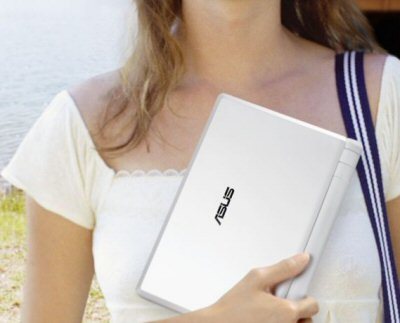Are 8.9-inch Netbooks on Their Way Out?
Last week Asus announced that it was discontinuing the 8.9-inch Eee PC, reports have emerged that say all netbook vendors are dropping the price of their 8.9-inch models in order to clear inventory. Is this the end of the 8.9 inch netbook?
A while back a story broke regarding talks between HP and Intel. HP was apparently trying to get Intel to ease its restrictions on its Atom processor so that it could use the ever so popular netbook CPU in netbooks with larger panels. Digitimes reported that HP's '09 roadmap showed the company hoped to add both an 11.6-inch model and a 13.3-inch model to its netbook line, with the 11.6-inch expected sometime in Q2 '09 and the 13.3-inch in June ’09.
The fact that manufacturers are discontinuing smaller netbooks and expressing the need for netbooks with larger panels suggests that the small panels aren’t really hitting the spot for consumers. That said, Asus has said the company will be keeping its 7-inch Eee PC as well as its 10-inch, detailing that 95 percent of Eee netbooks will be 10-inch models and 7-inch models will make up the other 5 percent, lending weight to the idea that the middling 8.9-inch sized panel is a sort of no man’s land market, which is neither big enough nor small enough.
This will likely bring about all kinds of trouble for Intel’s Atom. While HP is eager to see the restrictions eased so it can bring out bigger, Atom-based netbooks, Intel is probably going to be a little wary of making the Atom available for anything bigger than an 11-inch panel (the current restriction stands at a reported 10.2 inches, Dell Mini 12 aside). Intel has certain limitations on the Atom so as not to cannibalize sales of their more expensive CPUs. Basically, if you want to build a something bigger than 10.2 (and you're not Dell), you’ll have to use a more expensive processor like a Celeron or Pentium Dual Core.
Get Tom's Hardware's best news and in-depth reviews, straight to your inbox.

Jane McEntegart is a writer, editor, and marketing communications professional with 17 years of experience in the technology industry. She has written about a wide range of technology topics, including smartphones, tablets, and game consoles. Her articles have been published in Tom's Guide, Tom's Hardware, MobileSyrup, and Edge Up.
-
mdillenbeck Personally, if I am going to go to 10.2" screens I might as well stick to my 12" tablet PC.Reply
Would having a touch/stylus screen make the smaller screens more popular? Perhaps - however, with increased cost and probably questionable control, it may have done little to help this segment.
Unfortunately, it looks like the netbook market is about to die - instead, it is transforming into a low-cost laptop market. Those who want pocket-able will have to start looking at the UMPC market than wait and hope for netbooks to shrink. -
hellwig I don't get why the 8.9" was so unsuccessful. Compared to my 7" Cloudbook, my fiancee's 8.9" Acer is noticieably bigger. The 10" is bigger physically, but thats it. The monitor has the same resolution, and hardware internally is the same, it just has bigger pixels and bigger keys. For chrissake, if the keyboard is TOO small for you, get a normal laptop. You can get a Celeron or AMD laptop for the same price as a 10" netbook, and it will be more powerful too (Dell offers 15" w/ Celeron for $449).Reply
The only reason HP and Asus and the like want to make bigger notebooks with an Atom inside is to increase its profits. Cheaper hardware inside means more profit, pure and simple. Anyone buying a 13" "netbook" is a sucker. -
eddieroolz If I was to get a netbook today, I'll buy a 8.9incher. I'm not going to ride along with the OEMs on this one - screw them. Pocketability is the central concept to netbooks and if you force it to be larger then what's the point of a netbook? Might as well get a laptop.Reply -
philosofool hellwigThe only reason HP and Asus and the like want to make bigger notebooks with an Atom inside is to increase its profits. Cheaper hardware inside means more profit, pure and simple. Anyone buying a 13" "netbook" is a sucker.Well, you can price beneath your celeron/turion crowd if you fit your 13" with an atom. Also, the battery life on an atom equiped machine will be substantially better. I find myself wanting a portable computer but having little desire for a powerful one; mostly I want it to be cheap and portable.Reply -
JAYDEEJOHN Its amazing to assume that the AMD alternative doesnt exist. Theyve been pushing to get vendors, as it only makes sense to have better GFX and a somewhat larger layout, for people with big hands and poor eyesight, besides all the bells and whistles, which Atom cant do. AMD has a good chance in this market, and itll only serve Intel right by demanding what theyre demandingReply -
scryer_360 I don't see the reason for making Atom in larger computers than 10.2 inches. Once its that big, Core 2 Duo provides far more power and efficiency. It only doesn't provide the bare minimum power consumption, but the thing is about a 13.3 platform is that the screen will be using so much power and the (presumably installed) DVD drive will be using enough that the few watts the Atom shaves off won't matter.Reply
C2D for 13.3 and larger. Atom for anything smaller. Done. -
you know, the market of 7" screens are obsolete!Reply
Today you can get more horsepower out of a MID then an Asus EeePc 701!
Plus, the device is smaller, and about as cheap.
A reason few people buy a 9" mininetbook might be due to the too high salesprice, not really because they are less favorable.
I see no reason to continue selling a 9" device with a 7" screen (meaning 2" of lost space), while discontinuing exactly the same device but with higher resolution.
It makes little sense to buy a 10" mini notebook as well, those have the same resolution as their 9" brothers; and when buying a mininotebook, size matters!
The issue might rather be,that there are tens of different 9" devices on the market,and ASUS isn't the cheapest amongst them.
Many favor the MSI Wind and Acer Aspire One over the EeePc901. -
I don't particularly see the netbook market going down,rather going back to it's old roots, by creating small,cheap and affordable devices!Reply
The EeePc was supposed to be sold for $199. Current mininotebooks are sold 2,5x that price!
That is offer and demand!
Let asus be a bitch, by going against the flow. They definitely didn't sell more 10" eeepc's as 9" ones!
I see the market for olpc opening up again; cheap and affordable is the future!
For everyone!
I'll rather go with a VIA chipset than with the expensive ATOM chipset (that uses way more battery).
NVIDIA and VIA will probably be offering MY solution on a netbook in their via powered ion platform.
-
Tekkamanraiden I'm curious how much of a drop in price to clear them out. I'd gladly pick a $399 model up for $199.Reply -
zodiacfml i think it is both screen size and keyboard size that matter which explains the popularity of the 10in screen size netbooks.Reply
i've used an 10inch HP mini and i like it over my 14inch laptop which is not really portable compared to the Mini.
